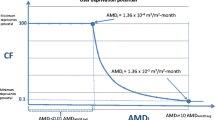Abstract
This paper aims at evaluating and revising the spatial and temporal sampling frequencies of the water quality monitoring system of the Jajrood River in the Northern part of Tehran, Iran. This important river system supplies 23% of domestic water demand of the Tehran metropolitan area with population of more than 10 million people. In the proposed methodology, by developing a model for calculating a discrete version of pair-wise spatial information transfer indices (SITIs) for each pair of potential monitoring stations, the pair-wise SITI matrices for all water quality variables are formed. Also, using a similar model, the discrete temporal information transfer indices (TITIs) using the data of the existing monitoring stations are calculated. Then, the curves of the pair-wise SITI versus distance between monitoring stations and TITI versus time lags for all water quality variables are derived. Then, using a group pair-wise comparison matrix, the relative weights of the water quality variables are calculated. In this paper, a micro-genetic-algorithm-based optimization model with the objective of minimizing a weighted average spatial and temporal ITI is developed and for a pre-defined total number of stations, the best combination of monitoring stations is selected. The results show that the existing monitoring system of the Jajrood River should be partially strengthened and in some cases the sampling frequencies should be increased. Based on the results, the proposed approach can be used as an effective tool for evaluating, revising, or redesigning the existing river water quality monitoring systems.
Similar content being viewed by others
References
Harmancioglu, N. B. (1981). Measuring the information content of hydrological processes by the entropy concept, Centennial of Ataturk’s Birth. Journal of the Civil Engineering, Faculty of Ege University, 1, 13–88.
Harmancioglu, N. B., & Alpaslan, N. (1992). Water quality monitoring network design: A problem of multi-objective decision making. Water resources bulletin, 28(1), 179–192.
Harmancioglu, N. B., & Baran, T. (1989). Effects of recharge systems on hydrologic information transfer along rivers. Proceedings of the Third Scientific Assembly—New Directions for Surface Water Modelling, IAHS Publications, 181, 223–233.
Harmancioglu, N. B., & Yevjevich, V. (1987). Transfer of hydrologic information among river points. Journal of Hydrology, 91, 103–118.
Harmancioglu, N. B., Fistikoglu, O., Ozkul, S. D., Singh, V. P., & Alpaslan, N. (1999). Water quality monitoring network design. Boston: Kluwer, 299 pp.
Karamouz, M., Kerachian, R., Zahraie, B., & Araghi-Nejhad, S. (2002). Monitoring and evaluation scheme using the multiple-criteria-decision-making technique: Application to irrigation projects. Journal of Irrigation and Drainage Engineering, ASCE, 128(6), 341–350.
Karamouz, M., Zahraie, B., & Kerachian, R. (2003). Development of a master plan for water pollution control using MCDM techniques: A case study. Water International, IWRA, 28(4), 478–490.
Karamouz, M., Zahraie, B., Kerachian, R., Jaafarzadeh, N., & Mahjouri, N. (2007). Developing a master plan for hospital solid waste management: A case study. Waste Management, Elsevier, 27(5), 626–638.
Karamouz, M., Nokhandan, A. K., Kerachian, R., & Maksimovic, C. (2009). Design of on-line river water quality monitoring systems using the entropy theory: a case study. Environmental Monitoring and Assessment, Springer, 155(1–4), 63–81. doi:10.1007/s10661-008-0418-z.
Masoumi, F., & Kerachian, R. (2008). Assessment of the groundwater salinity monitoring network of the Tehran region: Application of the discrete entropy theory. Water Science and Technology, IWA, 58(4), 765–771. doi:10.2166/wst.2008.674.
Masoumi, F., & Kerachian, R. (2010). Optimal redesign of groundwater quality monitoring networks: A case study. Environmental Monitoring and Assessment, Springer, 161(1–4), 247–257. doi:10.1007/s10661-008-0742-3.
Mogheir, Y., & Singh, V. P. (2002). Application of information theory to groundwater quality monitoring networks. Journal of Water Resources Management, 16, 37–49.
Mogheir, Y., de Lima, J. L. M. P., & Singh, V. P. (2004a). Characterizing the spatial variability of groundwater quality using the entropy theory: I. Synthetic data. Journal of Hydrolgical Process, 18, 2165–2179.
Mogheir, Y., de Lima, J. L. M. P., & Singh, V. P. (2004b). Characterizing the spatial variability of groundwater quality using the entropy theory: II. Case study from Gaza Strip. Journal of Hydrolgical Process, 18, 2579–2590.
Mogheir, Y., de Lima, J. L. M. P., & Singh, V. P. (2005). Assessment of informativeness of groundwater monitoring in developing regions (Gaza Strip Case Study). Journal of Water Resources Management, 19, 737–757.
Ozkul, S., Harmancioglu, N. B., & Singh, V. P. (2000). Entropy-based assessment of water quality monitoring networks. Journal of hydrologic engineering, 5(1), 90–100.
Saaty, T. L. (1980). The analytical hierarchy process, planning, priority, resource allocation. USA: RWS.
Saaty, T. L. (1994). Highlights and critical points in the theory and application of the analytical hierarchy process. European Journal of Operation Research, 74, 426–447.
Shannon, C. E., & Weaver, W. (1949). The mathematical theory of communication. Illinois: The University of Illinois Press.
Uslu, O., & Tanriover, A. (1979). Measuring the information content of hydrological process. Proceedings of the First National Congress on Hydrology, Istanbul, 437–443.
Water and Energy Research Center (1380). Pollution source identification and control in upstream of the Latyan dam. Technical Report, Sharif University of Technology.
Author information
Authors and Affiliations
Corresponding author
Rights and permissions
About this article
Cite this article
Mahjouri, N., Kerachian, R. Revising river water quality monitoring networks using discrete entropy theory: the Jajrood River experience. Environ Monit Assess 175, 291–302 (2011). https://doi.org/10.1007/s10661-010-1512-6
Received:
Accepted:
Published:
Issue Date:
DOI: https://doi.org/10.1007/s10661-010-1512-6




